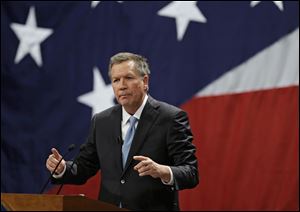
EDITORIAL
State of the State
Gov. Kasich says it’s his duty ‘to serve everyone,’ so why is he proposing another unneeded, unequal tax cut?
2/26/2014
Gov. John Kasich delivered his State of the State address Monday in Medina.
GOV. John Kasich launched this year’s re-election campaign with his State of the State address Monday night. The speech was designed to — and did — appeal to his core political constituency. Whether other Ohioans were equally persuaded by his insistence that “I’m your governor” is questionable.
Mr. Kasich asserted during his message that “I’m the governor of all of Ohio, and it’s my duty to serve everyone.” But the central policy prescription he offered this week was yet another unnecessary and unequal cut in the state’s personal income tax — a proposal that would serve the wealthiest Ohioans much better than everyone else.
The governor wants to reduce the top income tax rate from the current 5.33 percent to less than 5 percent. Doing so, the nonpartisan Institute of Taxation and Economic Policy calculates, would give the wealthiest 1 percent of Ohio taxpayers — with average annual incomes of more than $1 million — a tax cut of more than $2,500 a year. The bottom 20 percent of taxpayers, who make less than $19,000 a year, would get a cut of about $2.
Uneven relief
Neither figure merely reflects the amounts these groups pay in taxes. Instead, Mr. Kasich’s plan would give the richest Ohioans a disproportionately big break, despite his claim in his speech that “Ohio’s economy grows strongest when it grows from the bottom up.” And it would suck up revenue that the state otherwise could invest in education, infrastructure, other basic services, and aid to local governments.
Mr. Kasich boasted that during his term, he has reduced income taxes by 10 percent, eliminated the state inheritance tax, and cut taxes in half for many businesses. He did not quantify the cuts in essential state spending needed to pay for these $3 billion in regressive tax cuts.
The governor said his tax cuts have promoted the state’s economic recovery and helped create more than 170,000 private-sector jobs during his term. Democratic critics counter that Ohio’s current rate of job creation ranks near the bottom among states.
Although he didn’t mention it during his speech, Mr. Kasich evidently plans to pair his income tax cut with his sensible proposal to increase Ohio’s severance tax on oil and natural gas drilling. But that assumes his Republican colleagues in the General Assembly will change course and support that plan. Given the extent to which the GOP-controlled legislature is in thrall to Columbus’ fossil-fuel lobby, that seems a heroic assumption.
More positively, Governor Kasich’s message advanced an agenda of useful proposals for education, job training, and human services. Their presentation generally was longer on inspirational rhetoric than on details, including cost.
Better ideas
Still, it’s important to hear the governor acknowledge the responsibility of state government to ensure that mentally ill and drug-addicted Ohioans get the treatment and services they need. It’s heartening that he wants to spend real money on helping Ohioans stop smoking, or never start — a reversal of the state’s misguided refusal for years to make tobacco cessation a priority.
Mr. Kasich surely is correct that the state should do more to help communities such as Toledo make their public schools the hubs of neighborhood services, as well as centers of cooperation among parents, employers, and civic and religious groups to improve education. He is right to want to look for ways to expand vocational education and to keep young people from quitting high school.
On higher education, the governor is on track in basing more state aid on public colleges’ and universities’ graduation rates, and less on enrollment numbers. Enabling more students to get college credit for the college-level courses they take in high school can, as Mr. Kasich says, cut tuition costs.
Mr. Kasich properly envisions a greater role for community colleges in helping dropouts get the education they need. Enabling veterans to earn academic credit for their military training and experience, as he proposes, will enlarge the state’s pool of skilled workers.
The governor also talked this week about raising “standards” for publicly subsidized preschool education in Ohio, and promised to “make it work.” But he didn’t pledge to increase the state’s investment in early-education programs.
The good ideas in Mr. Kasich’s address will need fleshing out when he offers his formal review of the two-year state budget in the next few weeks. It’s to be hoped his tax-cut enthusiasm won’t get in the way of realizing his other goals.
Toward the end of Monday’s speech, Governor Kasich offered a plaintive message to the lawmakers and others in his audience: “Please don’t let the fact that we’re in an election year make us weak, too partisan, not willing to take on big issues.” That is a critical warning, and the governor can work to keep that from happening by setting an example of courageous, policy-oriented, bipartisan leadership for the rest of the year.
Such a show of strength wouldn’t be a bad platform for his re-election in November, either.